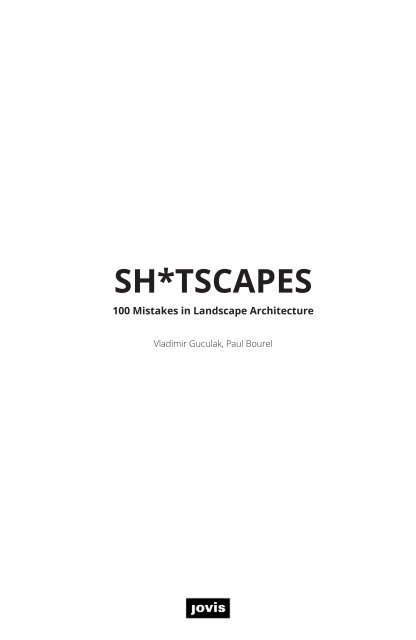Sh*tscapes
ISBN 978-3-98612-076-4
ISBN 978-3-98612-076-4
- No tags were found...
You also want an ePaper? Increase the reach of your titles
YUMPU automatically turns print PDFs into web optimized ePapers that Google loves.
SH*TSCAPES<br />
100 Mistakes in Landscape Architecture<br />
Vladimir Guculak, Paul Bourel
Contents<br />
An Atlas of Failures<br />
Paving<br />
#01–10<br />
Drainage<br />
#11–17<br />
Access Covers<br />
#18–24<br />
Street Furniture<br />
#25–39<br />
Trees<br />
#40–66<br />
Planting<br />
#67–89<br />
Kerbs and Edges<br />
#90–100<br />
08<br />
10<br />
20<br />
26<br />
33<br />
47<br />
74<br />
91
An Atlas of Failures<br />
As cities worldwide transform to address the urgent climate crisis, our public spaces<br />
have become a symbol of change for greener and healthier urban environments. Driven<br />
by global, national and regional policies over the past decades, our public realm is set<br />
to become a sustainable green and blue infrastructure that offers socially equitable,<br />
accessible and ecologically conscious spaces. In recent years, the COVID-19 pandemic<br />
renewed our love for the outdoors, re-energising public and private sector efforts, and<br />
helping to place our streets, squares, parks and plazas at the centre of sustainable<br />
development targets.<br />
In the United Kingdom, such efforts saw the implementation of low-traffic<br />
neighbourhoods, green streets programmes, funding for tree planting, government<br />
support for sustainable regeneration and obligations for biodiversity net gains 1 . As a<br />
result, new developments will prioritise green open spaces and ecological enhancements,<br />
helping to contribute to the ambitious national statutory target of 16.5% tree cover by<br />
2050 2 .<br />
This momentum, seen in major cities across the globe, inevitably triggers questions<br />
around implementation and monitoring. With a public realm often underfunded,<br />
forgotten, and sidelined for major infrastructure projects and public buildings, it is crucial<br />
to investigate how these aspirational changes will be delivered, built and maintained.<br />
Recent statistics by the UK’s Forestry Commission show that mortality rates for new trees<br />
often reach as high as 50%, with around 30% of urban trees dying within 12 months after<br />
being planted 3 . With the UK’s allocated parks budget dramatically declining by £100’s<br />
of millions since the early 2000s 4 , it is crucial to understand how these policies will be<br />
implemented and what our public spaces will look like in the future.<br />
To help deliver this better future, <strong>Sh*tscapes</strong> takes a pragmatic look at what has been built<br />
so far. It offers practical solutions to recurring problems which appear across our cities<br />
around the world. Started in 2019 and based on case studies in London, this project<br />
surveys 100 common issues and draws universal conclusions meant to assist planners,<br />
urban designers, architects, landscape architects and contractors in their endeavours. In<br />
other words, the publication is a compendium of failures and mistakes to watch out for<br />
during a project’s planning, design, construction and maintenance stages.<br />
Aggravated by the advent of the internet and social media, the architecture world is<br />
hyper-focused on glossy images and flawlessly built projects. Rarely do we see a building’s<br />
delivery process or how it stands the test of time. Ironically, the time-based discipline<br />
of landscape architecture follows this trend as well. <strong>Sh*tscapes</strong> makes the argument for<br />
learning from our failures. This book purposefully showcases a mixture of established<br />
and recently built projects to reveal design and construction mistakes and uncover the<br />
more subtle imperfections appearing after long-term use.<br />
Unlike buildings and large infrastructure projects, our streets, squares and green spaces<br />
are relatively simple to build. Sadly, urban design and landscape architecture publications<br />
tend to focus on extraordinary projects, often documented shortly after completion<br />
and without a focus on detail, making it hard for students and young professionals to<br />
understand how things are built.<br />
To bridge the gap, <strong>Sh*tscapes</strong> covers mostly standard design details, construction and<br />
maintenance practices. To this end, the book is structured as a checklist covering the<br />
8 <strong>Sh*tscapes</strong>: 100 Mistakes in Landscape Architecture
asic elements that typically make up a public space: paving, edges, drainage, furniture,<br />
trees and planting. And although not exhaustive, it is intended as a reminder of all the<br />
things that could go wrong throughout the life of a project.<br />
We hope to encourage our readers to study their environment and practice their<br />
observational skills to expand the sh*tscapes library.<br />
This publication intends not to shame or blame an individual or a group. The<br />
photography deliberately hides the location and context of each problem to better<br />
highlight its universality. Often, a sh*tscape illustrates an accumulation of failures over<br />
time, attributed to a lack of coordination, attention and continuity between all parties<br />
involved. In this book, the source of the problem is trivial compared to the search for<br />
solutions, of which there are often many. Should an individual recognise their work, we<br />
thank them for contributing to teaching future generations.<br />
About the Authors<br />
Vladimir Guculak and Paul Bourel are both landscape architects and founders of studio<br />
gb, based in London, UK, a landscape architecture and design practice centred on the<br />
idea that thorough investigation and analysis should always guide how we shape the built<br />
environment. The research-led studio is devoted to meticulous observation, mapping,<br />
photography and documentation of urban surroundings.<br />
For over a decade, Vladimir and Paul studied our cities’ extraordinary complexities,<br />
contradictions and constraints with a view to embedding lasting green spaces in our<br />
increasingly mineral habitat. This research has resulted in a unique specialisation in<br />
patterns of social distancing, green walls, urban tree planting, detailing and sustainable<br />
materials. Their work is predicated upon craft, observation, research, engagement and<br />
environmentally sustainable solutions to establish unique areas of serenity, resilience and<br />
solidarity in an accelerating world.<br />
1<br />
2<br />
3<br />
4<br />
In England, biodiversity net gain (BNG) is mandatory under Schedule 7A of the Town<br />
and Country Planning Act 1990 (as inserted by Schedule 14 of the Environment Act<br />
2021).<br />
M. Broadmeadow, ‘England Tree Planting Increases for 2022/23’, Forestry Commission<br />
Blog [web blog], 16 June 2023, https://forestrycommission.blog.gov.uk/2023/06/16/,<br />
(accessed 7 January 2024).<br />
Carbon Gold, Carbon Gold Highlights Urban Tree Survival Rates [website], https://www.<br />
carbongold.com/carbon-gold-highlights-urban-tree-survival-rates/,<br />
(accessed 7 January 2024).<br />
K. Martinsson et al., ‘Funding for England’s parks down £330m a year in real terms<br />
since 2010’, The Guardian [online news article], 13 August 2022, https://www.<br />
theguardian.com/environment/2022/aug/23/funding-for-englands-parks-down-<br />
330m-a-year-in-real-terms-since-2010, (accessed 7 January 2024).<br />
An Atlas of Failures<br />
9
#01<br />
A standard concrete flag was cut into a C-<br />
shape, creating weak points in the paver<br />
and leading to apparent cracks.<br />
01<br />
Every time a standard slab is cut to fit<br />
around existing or new elements, such<br />
as a bollard or railings, the possibility of<br />
creating vulnerable, weak points is high.<br />
Therefore, carefully setting out your paving<br />
layout beforehand is critical. It is best to<br />
minimise cuts by rearranging the paving<br />
layout and introducing oversized slabs or<br />
to make necessary cuts to reduce weak<br />
points.<br />
Laying flags on a flexible sand-based<br />
laying course may further exacerbate the<br />
problem as pressure from pedestrians<br />
and vehicles often creates an uneven base<br />
over time that will not support the paving<br />
evenly and properly.<br />
fig. 01<br />
01 – paving slab<br />
02 – bollard<br />
02<br />
10 <strong>Sh*tscapes</strong>: 100 Mistakes in Landscape Architecture
#02<br />
A slab was cut in an L-shape to fit around<br />
an existing manhole cover. The difference<br />
in settlement between the paving base<br />
and the cover added pressure to the weak<br />
point in the paver. You can clearly see the<br />
resulting tension release cracks.<br />
Carefully setting out the paving is<br />
critical, and it is best to minimise cuts<br />
by rearranging the paving layout and<br />
introducing oversized slabs or make<br />
necessary cuts to reduce the tension.<br />
fig. 02<br />
02<br />
01<br />
Sometimes using smaller paving units is<br />
beneficial if you want to avoid awkward<br />
cuts and tricky setting out issues,<br />
especially in areas filled with access covers<br />
for utilities, bollards and street furniture.<br />
01 – manhole cover<br />
02 – paving slab<br />
Paving<br />
11
#05<br />
It is common for tactile Yorkstone paving<br />
to weather rapidly and, as a result, no<br />
longer serve its purpose.<br />
Make yourself familiar with the properties<br />
of each stone. Some natural stones are<br />
not appropriate for heavy pedestrian<br />
traffic. When choosing a material for<br />
tactile paving, select a robust and hardy<br />
stone that does not erode over time. Most<br />
sedimentary rocks like sandstones and<br />
limestones are likely to wear fast when<br />
exposed to heavy footfall.<br />
Alternatively, a replacement strategy must<br />
be put in place so that the weathered<br />
stones can be easily substituted.<br />
Small stainless steel studs may be installed<br />
instead of carved-out blisters, depending<br />
on local guidance. Studs may also become<br />
loose over time.<br />
Using Yorkstone as a flat paving surface<br />
is often not a problem, but any relief<br />
or carved-out features will become<br />
vulnerable and deteriorate over time. For<br />
long-lasting tactile paving, harder stones<br />
like granite should be considered.<br />
14 <strong>Sh*tscapes</strong>: 100 Mistakes in Landscape Architecture
#06<br />
Narrow carriageways with inappropriate<br />
paving designs can lead to significant<br />
failures.<br />
In this example, a heavily trafficked,<br />
one-way carriageway coexists next to a<br />
designated cycle lane and a pedestrian<br />
footpath.<br />
Unfortunately, the colour of the natural<br />
stone slabs, blocks and kerbs are very<br />
similar to the adjacent road surface,<br />
making it difficult for drivers to see the<br />
roadway. In addition, the shallow kerbs<br />
and insufficient build-ups made the<br />
surfaces vulnerable to heavy vehicles,<br />
resulting in a failed paving system and<br />
patchwork repairs.<br />
Engineers should always check road and<br />
paving build-ups, while designers should<br />
consider vehicular build-ups in pavements<br />
for shared surfaces. The indicative<br />
section (fig. 03) shows the appropriate<br />
below-ground construction layers for this<br />
condition.<br />
Paving<br />
fig. 03<br />
01<br />
04 04<br />
02<br />
06 06<br />
05<br />
03<br />
07<br />
01 – natural stone paving slabs<br />
02 – natural stone kerb<br />
03 – natural stone paving blocks<br />
04 – bedding layer<br />
05 – concrete base*<br />
06 – compacted granular sub-base layer*<br />
07 – compacted subgrade layer*<br />
*thickness to be determined based on the<br />
anticipated loading and existing ground<br />
conditions<br />
15
#22<br />
The paving inside this recessed manhole<br />
cover has caved in under the pressure of<br />
heavy vehicles running over it.<br />
05<br />
Recessed stainless steel manhole covers<br />
are great when trying to hide access points<br />
in newly paved areas. However, several<br />
factors have to be considered. First, the<br />
cover should be designed to withstand the<br />
expected vehicular loads. The recess has<br />
to be deep enough to allow for a bedding<br />
layer and the paver depth. A chemically<br />
fixed thinner slab can sometimes be used<br />
under occasional light loading.<br />
fig. 12<br />
02<br />
01<br />
04<br />
03<br />
Wherever feasible, avoid placing manholes<br />
in heavily trafficked areas or, alternatively,<br />
use a more robust cast iron cover.<br />
01 – recessed cover<br />
02 – paving blocks<br />
03 – bedding layer<br />
04 – concrete foundations<br />
05 – car<br />
30 <strong>Sh*tscapes</strong>: 100 Mistakes in Landscape Architecture
#23<br />
Our streets and public spaces are built<br />
over layers of buried utilities and services<br />
accumulated over centuries.<br />
Landscape architects should seek to<br />
incorporate survey information into<br />
their designs and work around services<br />
that are unlikely to be relocated. Timely<br />
coordination with MEP and civil engineers<br />
will result in a more integrated and<br />
coherent layout.<br />
However, it is sometimes impossible to<br />
know what sits below the site, and a few<br />
surprises may appear during demolition.<br />
This example is a reminder to always stay<br />
flexible and keep an open mind when<br />
encountering clashes later in the design<br />
process.<br />
Often, large-scale urban projects have the<br />
capacity to rationalise existing belowground<br />
services, eliminate redundant<br />
runs or replace aged ducts and cables.<br />
The budget and implications on the<br />
construction sequence should be carefully<br />
assessed at the beginning of the project.<br />
Access Covers<br />
31
#55<br />
This cast-iron tree grill cover has an<br />
insufficiently sized opening that did not<br />
consider the tree’s future growth and<br />
expansion.<br />
Grills are an excellent tool for widening<br />
pavements in dense urban settings. It<br />
is important to remember that their<br />
weight should be distributed away from<br />
the root ball. And as the tree becomes<br />
established, this cover should be removed<br />
or substituted with a larger one.<br />
60 <strong>Sh*tscapes</strong>: 100 Mistakes in Landscape Architecture
#56<br />
This tree was planted too close to a road<br />
kerb, creating long-term maintenance<br />
issues.<br />
The London plane (Platanus x hispanica) is<br />
one of Europe’s most popular urban trees.<br />
They are tough, have a long lifespan, and<br />
can be easily pollarded and shaped to<br />
work in many different urban conditions.<br />
A London plane can grow up to 30m high,<br />
and its trunk can achieve a girth of over<br />
2m. Therefore, it is crucial to carefully<br />
place young trees away from buildings,<br />
structures and, as in this case, road kerbs.<br />
Alternative tree species should be<br />
considered when the street profile<br />
doesn’t allow enough space for a large<br />
tree canopy. Refer to a helpful guide from<br />
TDAG for further information.<br />
Trees<br />
61
01<br />
03 05 07 08<br />
04 09<br />
02<br />
05<br />
10<br />
11<br />
06<br />
12<br />
fig. 17<br />
01 – tree<br />
02 – root ball dimension will vary<br />
depending on the tree size<br />
03 – paving slabs<br />
04 – hard landscape edge to be neatly cut<br />
or shuttered to maximise space for roots<br />
05 – structural soil<br />
06 – below-ground anchoring system<br />
07 – gravel mulch<br />
08 – irrigation pipe<br />
09 – aeration pipe<br />
10 – structural soil cells<br />
11 – gravel layer<br />
12 – subgrade<br />
62 <strong>Sh*tscapes</strong>: 100 Mistakes in Landscape Architecture
01<br />
03 12 07 08 09 04<br />
10<br />
02<br />
05<br />
05<br />
10<br />
11<br />
06<br />
12<br />
fig. 18<br />
01 – tree<br />
02 – root ball dimension will vary<br />
depending on the tree size<br />
03 – paving slabs<br />
04 – root barrier<br />
05 – subsoil<br />
06 – below-ground anchoring system<br />
07 – recessed steel tray with paving slabs<br />
cut to fit<br />
08 – loose gravel around the trunk<br />
09 – irrigation pipe<br />
10 – aeration pipe<br />
11 – structural soil cells<br />
12 – topsoil<br />
13 – subgrade<br />
Trees<br />
63
© 2024 by jovis Verlag<br />
An imprint of Walter de Gruyter GmbH, Berlin/Boston<br />
Texts by kind permission of the authors.<br />
Pictures by kind permission of the photographer.<br />
All rights reserved.<br />
Cover design: jovis Verlag<br />
Photography: Vladimir Guculak<br />
Proofreading: Bianca Murphy<br />
Design and setting: Vladimir Guculak and Paul Bourel<br />
Lithography: Bild1Druck, Berlin<br />
Printed in the European Union.<br />
Bibliographic information published by the Deutsche Nationalbibliothek<br />
The Deutsche Nationalbibliothek lists this publication in the Deutsche<br />
Nationalbibliografie; detailed bibliographic data are available on the Internet at<br />
http://dnb.d-nb.de<br />
jovis Verlag<br />
Genthiner Straße 13<br />
10785 Berlin<br />
www.jovis.de<br />
jovis books are available worldwide in select bookstores. Please contact your nearest<br />
bookseller or visit www.jovis.de for information concerning your local distribution.<br />
ISBN 978-3-98612-076-4 (softcover)<br />
ISBN 978-3-98612-077-1 (e-book)


















